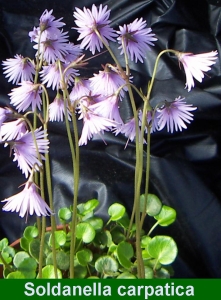Families

The two parts to the Latin name, genus and species,
given to every organism are all that is
needed to define it. But the classification system extends both upwards and downwards. There may be
sub-species, varieties and/or forms of the species, and there are larger groups, into which genera
are grouped.
In the first place, genera are grouped into families. Thus, for example, the genus Primula is
in the family Primulaceae, but so are many other related families, including Androsace
(sometimes known as rock jasmines), Soldanella (the snowbells of the European Alps), Cyclamen,
the American shooting stars (Dodecatheon) and the genus that includes our lovely British weed, the
scarlet pimpernel (Anagallis).
The up-to-date names of plant families are derived from the first-named genus in the family, and end
with the letters -aceae. Thus Primulaceae is derived from Primula, and the origins of Rosaceae
and Campanulaceae are obvious - while that of Elaeocarpaceae isn't!
Making all family names comply with this rule meant that some long-established ones had to be changed. So
we no longer have Compositae and Cruciferae, but Asteraceae and Brassicaceae
instead. On other occasions family names are changed, in the same way as those
of genera and species, because of advances in botanical knowledge. So the
large Liliaceae family was split into a host of smaller families, including Trilliaceae,
Hyacinthaceae and Alliaceae, containing, amongst others, trilliums, hyacinths and bluebells,
and onions, respectively. There is still a Liliaceae family, but it is much smaller, and now is
restricted to the genus Lilium and some close relatives.
However, there have been more changes, although the good news is that we are probably converging on a more stable system, based on sound genetic and morphological evidence. The latest version of this is called the Angiosperm Phylogeny Group III systemn (AGP-III for short). There is a very good explanation of this on Wikipedia, which includes a complete list of families. Of course, this doesn't directly help you to find the correct family for any particular genus, but it is a start. On our web site we are using these latest families, but if you find any mistakes, please let us know.
